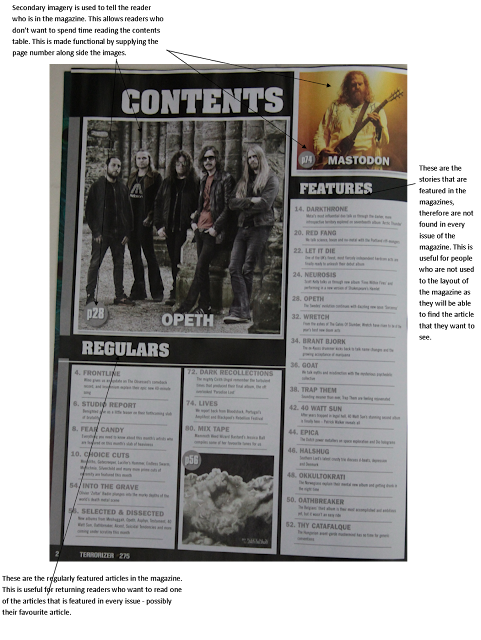Cover
Page
In the above image I have highlighted the key
features of the cover of Rock Sound, issue 218. As you can see, this issue of
Rock Sound is a special edition – an issue dedicated to My Chemical Romance’s
album 10th anniversary. Because of this the entire font cover
follows a similar colour scheme to the outfits worn by MCR. Furthermore, the
use of gold typography gives a sense of triumph for the band as their record
has reached the age of 10 and is still one of the most iconic and well known
albums in the genre. The colour gold also provides added value allowing them to
charge more for the overall quality of the magazine.
Even though it is a special edition of Rock Sound,
the magazine still follows the codes and conventions of a music magazine in
this genre. These codes and conventions include; a skyline – this is useful for
advertising the magazine if it is stacked one above the other, rather than one
next to the other. This partnered with the left-third masthead enables Rock
Sound to ensure they are always seen, therefore possibly increasing sales. Pugs
and Puffs are also used to give the reader more incentive to buy the magazine,
for things like “free” posters and a “free” CD.
Contents
Page

In the above photograph I have highlighted the key
features found on the contents page of Rock Sound issue 218. As you can see,
the contents page follows the codes and conventions of an Alt/Rock magazine loosely.
One immediate and obvious difference between this magazine and others of the
same genre is that the cover star does not take up a large portion of the
contents page with a single large photograph. The main image has been replaced
with 3 secondary images, one of which features the cover star. I believe this
was done because this issue, while being a special edition of Rock Sound,
features stories and articles form many other bands – some of whom have their
double page spreads have been photographed and placed above the main featured
story. If you look closely at the 3 double page spreads that have been used,
you will notice a pattern, the first image is a light and bubbly image that is
welcoming. The second image down is somewhat a deep blue which could symbolise
a deep though process – which matches the imagery used. Finally, you have the
image of My Chemical Romance (MCR) which is dark and gloomy. Looking at these 3
contrasting images creates a sense of build-up, especially because readers tend
to read from top to bottom.
Double
Page Spread
In the above image, I have highlighted the key features
found on one of many Double Page Spreads found in Rock Sound, issue 218. Because
this issue is a special edition tribute magazine for MCR’s The Black Parade
record, there were many double page spreads used in this magazine. The reason I
picked this one to analyse was solely down to the Photography. The image creates
symbiosis with the brand and the house colour of this issue through their
clothing. Furthermore, some may argue that the lighting in the background of
the image also contributes to the symbiosis, as on the front cover, gold is
used as the main cover lines typography colour.
Also, the use of the anchorage text is effective at
creating a break between the multiple-page story; preventing the reader
becoming bored. The use of the white typography that does not follow strict
font lines (i.e. is a “wavy” font) contrasts the very uniform look of the rest
of the double page spread.


























